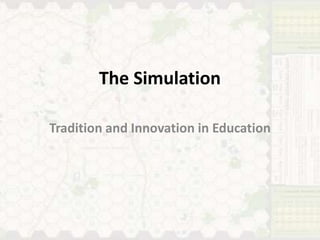
The Simulation
- 1. The Simulation Tradition and Innovation in Education
- 2. The 4 values of Board Wargaming
- 3. Why Simulating ? • Simulating is essentially an open ended exercise but three main aims can be identified: 1) Each student can “handle” directly the event 2) It’s possible improving a foreign language 3) It’s an activity that can increase Self Confidence and Leadership
- 4. The Historical Simulation • Napoleon at Waterloo is the wargame (a synonym that stands for simulation) that recreates a famous battle. It’s useful to explain the main concepts of the simulation.
- 5. The Equipment – The Map
- 6. The Playing Pieces (Counters) • Boardgame counters are usually small cardboard squares moved around on the map of a wargame to represent armies, military units, or individual military personnel. Usually the main digits indicate strength and movement (in hexes). It’s possible finding other information.
- 7. Terrain and Combat Charts The combat is resolved by using a combat tableTerrain effects on play
- 8. The ZoC (Zone of Control) • It represents the hexes adjacent to hexes occupied by units. • Zones of control commonly are used to represent the portion of the map over which a military ground formation has a direct influence, due to the range of its weapons and the distance its sub-units may deploy from its center of gravity:
- 9. The Sequence of Play • The players take turns moving their units and making attacks. Each turn is divided into several steps. • First Player turn • Reinforcements (not always) • Movement • Combat • Second player turn • Same as above • There is sometimes and interphase common to both players
- 10. The Movement Phase • Each unit has a Movement Allowance number printed on it which represents the basic number of hexes it may move in a single Movement Phase. Each Player moves only his own units during the Movement Phase of his Player-Turn (as outlined in the Sequence of Play).
- 11. The Combat Phase • Each unit has a Combat Strength number printed on it which represents its basic power to attack during its Combat Phase and to defend during the Enemy Combat Phase. Whether or not a unit can attack is strictly a matter of how it is positioned with respect to Enemy units. All units that are in Enemy Zones of Control must attack during their Combat Phase; artillery units not in Enemy Zones of Control but that have Enemy units within the range of their guns may execute a special form of attack called bombardment.
- 12. And the Winner is… • Napoleon at Waterloo is won by the player who most steadily destroy enemy units
- 13. The Reading • The students are requested to read the extract about Waterloo. A final test about that and the game itself will be the final step.
- 14. Assessment Test (I) • 1) What are the main components of a simulation? • 2) What does ZoC stand for? • 3) Generally when a unit enters a zoc, what could happen? • 4) What do you use when you have to solve a combat? • 5) A unit generally owns a movement allotment. What do you consider to check a correct movement? • 6) Two numbers are usually printed on a cardboard counter. What do they point out? • 7) How can we divide the sequence of play? • 8) What do you consult if you want to check the arrival of the reinforcements? • 9) What’s the geometric shape superimposed on the mapboard? • 10) Where is printed the unit designation?
- 15. Assessment Test (II) • 1) When did the Battle of Waterloo take place? • 2) Who were the three leaders of the armies involved? • 3) Why did Napoleon decide to attack Hougomont? • 4) What was Napoleon’s main effort? • 5) Why did Napoleon hurry his attack? • 6) Which kind of weapon did Napoleon use to start the attack? • 7) What did Wellington do after the French Guard retreated? • 8) Why did Napoleon commit the French Guard? • 9) Where did the French army fight against the Prussian Army? • 10) What were the Wellington’s advantages and disadvantages?
- 16. Assessment Test (III) • 1) The verb to withdraw stands for… Please look up the word in the extract • 2) Please give three examples about the passive • 3) What about the infinitive of the verb “fed”? • 4) Please translate into Italian: The battle opened at 11:50 am with a cannonade and one- division assault on Hougomont, a walled manor constituting a sort of natural redoubt guarding the approach to the Allied right • 5) Please highlight a phrase where there is a past perfect tense • 6) Please write no more than 40 words to sum up the extract • 7) Please underline an example about the superlative • 8) Please look up in the extract a synonym that stands for “varied”. • 9) Please translate into English: • Napoleone fu costretto a ritirarsi a causa della sconfitta della Guardia Francese • 10) What’s the Italian word that stands for “repulse”
- 17. Assessment Test (IV) • Please write a short essay made up of at least 40 words about what Napoleon could do to avoid his defeat. You are allowed to write it also in Italian.
